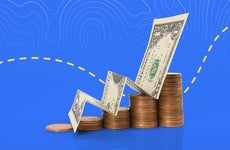Step-up CDs: What they are and how they work

The Bankrate promise
At Bankrate we strive to help you make smarter financial decisions. While we adhere to strict , this post may contain references to products from our partners. Here's an explanation for .
Investors who are averse to risk may want to explore certificates of deposit (CDs), which offer a guaranteed rate of return and a fixed interest rate — both of which can soothe investor jitters.
When you invest in a CD, you agree to tie up your savings for months or years at a time at a fixed rate of return. With a step-up CD, you’re not only locking in a rate, but also getting the opportunity to earn a higher rate of return later on with a rate increase.
Here’s what you need to know about step-up CDs and whether they’re right for you.
What is a step-up CD?
Like traditional CDs, a step-up CD is a deposit account that allows savers to lock in an interest rate for a set number of months. Before the step-up CD matures, however, the interest rate associated with the account increases a predetermined amount on scheduled dates.
For example, a step-up CD might start with a 0.3 percent interest rate and increase by 0.1 percent annual percentage yield (APY) every six months for two years. The rates over time would be:
- First six months: 0.3 percent APY
- Next six months: 0.4 percent APY
- Next six months: 0.5 percent APY
- Final six months: 0.6 percent APY
Early withdrawal penalties still apply with step-up CDs, which means you’ll pay a price for pulling the money out of your account before it matures.
Step-up CDs are offered by fewer banks than traditional CDs are.
How step-up CDs work
Step-up CDs are sometimes referred to as bump-up CDs. But in reality, they’re two different products.
Bump-up CDs give account holders the option to raise their APY at least once before the end of their term, upon request. For example, the United States Senate Federal Credit Union offers 3-, 4-, and 5-year bump rate certificates, each featuring a one-time rate increase.
With step-up CDs, on the other hand, predefined rate increases happen automatically at certain intervals, says Greg McBride, CFA, Bankrate’s chief financial analyst. With a bump-up CD, you might be concerned about timing your rate increase perfectly, which is when a step-up CD could be a better option.
Step-up CD features
Here are the distinguishing features of step-up CDs that can help you determine whether it’s a fit for your deposits.
- Lower initial interest rate: Step-up CDs start with an initial rate that’s usually lower than the fixed rate on a comparable traditional CD. To see how much you’d earn overall, factoring in rate increases, look at the blended interest rate.
- Predetermined rate increases: The rates for a step-up CD aren’t left up in the air, as with a bump-up CD. They’re predetermined, and the account holder is informed of when and by how much the rate will increase during the term.
- Minimum opening deposit: Step-up CDs tend to have higher minimum deposits to open than other types of accounts, like savings accounts. They tend to range between $1,000 to $2,500. That’s not always the case, though — at TD Bank, for example, the minimum opening deposit is only $250.
- Term options: Step-up CDs may have fewer term options than traditional CDs, as they’re a specialty product. In most cases, the available terms will be at least one year, giving enough time for the rate increases.
- Early withdrawal penalties: Like most CDs, step-up CDs will usually have penalties for early withdrawal of any of the funds. You may have to forfeit a certain number of months’ worth of interest, depending on how long the CD term is for.
Beware the blended yield
When you’re comparing step-up CD rates, be sure to look out for blended APYs. A blended APY is not simply what you’re earning at each interval, but rather is the effective rate you’re earning on the CD balance that factors in the rate increases.
U.S. Bank, for instance, offers a 28-month step-up CD. The interest rate tied to the CD increases every seven months:
- First seven months: 0.05 percent APY
- Next seven months: 0.25 percent APY
- Next seven months: 0.45 percent APY
- Final seven months: 0.65 percent APY
But the blended annual yield, or the effective rate of the four intervals listed above, is 0.35 percent APY. So, if you don’t incur any penalties from withdrawing money before the maturity, 0.35 percent APY is the yield you’d receive.
Often with step-up CD deals, comparable offers for traditional CDs are much more appealing.
“Just because it is slated to increase at regular intervals throughout the term of the CD doesn’t necessarily mean you’re going to end up better off at the other end,” McBride says. “It depends on the starting point and the magnitude of the increase.”
To invest or not to invest?
A step-up CD may seem like your best bet if you want a fixed rate of return that you’re certain will increase over time. But choosing where to invest your money should be based on several factors.
“Any investment that you make should have a financial plan and goals that are guiding that decision,” says Taylor Schulte, founder and CEO of Define Financial, a San Diego-based registered investment advisor.
If CDs are a good fit for your portfolio and you’re concerned about declining rates, consider building a CD ladder, where you buy multiple CDs at the same time with different terms. When the shorter-term CDs mature, renew them or replace them with new ones. At the same time, you’ll have longer-term CDs in the mix that will likely pay a higher yield than the shorter-term ones.
“You’ll likely see a higher rate of return in your portfolio by building that laddered CD portfolio versus letting the bank do it for you,” Schulte says.
Alternatives to step-up CDs
Consider shorter-term CDs instead if you don’t want to lock up your money for the duration of a given step-up CD. Having access to your funds relatively soon can be beneficial if rates rise or if you decide to start investing the money elsewhere.
You may also choose a bump-up CD that lets you request one or more rate increases during the term. This might be a good option in a rising rate environment, so you can take advantage of a higher rate offered by the bank at your own will.
Like step-up CDs, bump-up CDs typically carry an early withdrawal penalty. There are no-penalty CDs available, if being able to withdraw money early is an important factor.
Other alternatives to step-up CDs include high-yield savings accounts and short-term bond funds, which often carry similar terms to CDs and can provide strong yields. Money market accounts can also earn a competitive rate of return, and they conveniently allow you to withdraw money without penalty.
Bottom line
Step-up CDs present an attractive option for those who want to capitalize on interest rate increases over the CD term without the need to actively monitor their investments. While the rate increases can be a perk, it’s also important to factor in interest rate trends.
“Like umbrellas on a rainy day, bump-up and step-up CDs tend to appear and appeal most in a rising interest rate environment,” Bankrate’s McBride says.
The blended yield of a step-up CD might not always be competitive with traditional CDs or other deposit accounts, so compare options and ensure that you can meet any minimum requirements before committing to a term.
— Bankrate’s René Bennett contributed to an update of this story.
Related Articles



